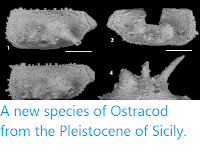Ostracods are small Crustaceans with a bivalved body plan; their
body is sandwiched laterally between two large valves, with the animal using
its legs to generate a current through the shell, enabling it to feed, and in
many cases swim (check). Ostracods are small (seldom much over a millimetre)
and can be very abundant, making them common fossils in many deposits. They
also often have distinctive shell ornamentation, enabling the identification of
species from valves alone, and are both fast-evolving and sensitive to a range
of environmental conditions, making them useful in both biostratigraphy (dating
rocks using fossils) and palaeoenvironmental reconstruction. Methane cold seeps are considered to be important environments for understanding past climate change, as methane hydrates (ice deposits with trapped methane) form extensive deposits in Arctic regions, which are thought to release large amounts of methane during times of rapid global warming, which, since methane is a far more powerful greenhouse gas than carbon dioxide, makes identifying methane seeps importanr for understanding past climate change. Since Ostracods are known to inhabit methane cold seeps, they are a potential useful tool for identifying past cold seep deposits, though at the moment Ostracods from these environments are little studded.
In a paper published in the Journal of Micropalaeontology on 5 January 2018, Moriaki Yasuhara of the School of Biological Sciences and Swire Institute of Marine Science at the University of Hong Kong, Kamila Sztybor and Tine Rasmussen of the Centre for Arctic Gas Hydrate, Environment and Climate at the Arctic University of Norway, Hisayo Okahashi, also of the School of Biological Sciences and Swire Institute of Marine Science at the University of Hong Kong, Runa Sato, again of the School of Biological Sciences and Swire Institute of Marine Science at the University of Hong Kong, and of the Department of Marine Biosciences at the Tokyo University of Marine Science and Technology, and Hayato Tanaka of the Research Center for Marine Education at the University of Tokyo, describe a new species of Ostracod from methane cold seeps on the western Svalbard margin.
The new species is named Rosaliella svalbardensis, where 'Rosaliella' honours Rosalie Maddocks of the University of Houston for her work on Ostracods from chemosynthetic environments, and 'svalbardensis' means 'from Svarlbad'. The species is 642-680 μm in length, with a reticulated surface covered in clusters of pores. Such clusters of pores have been areas where chemosynthetic Bacteria are found, and have been suggested to be used to house symbionts.
Scanning electron microscopy images of Rosaliella svalbardensis. (a)–(e) Adult, female, 0–1 cm depth. (f)–(j) Adult, female, 0–1 cm depth. (k)–(n) Adult, female, 0–1 cm depth. (o)–(q) Adult, female, 0–1 cm depth. (a), (c), (f), (h), (l), (n), (o) Lateral views. (b), (d), (e), (g), (i), (j), (k), (p), (q) Internal views. Scale bars: 1mm for (a), (b), (f), (g), (l), (m), (o), (p); 100 μm for (d), (i); 50 μm for (c), (e), (h), (j), (k), (n), (q). 1mm scale bar in the middle part of the figure. Other scale bars in each panel. Yasuhara et al. (2018).
See also...
Follow Sciency Thoughts on Facebook.







